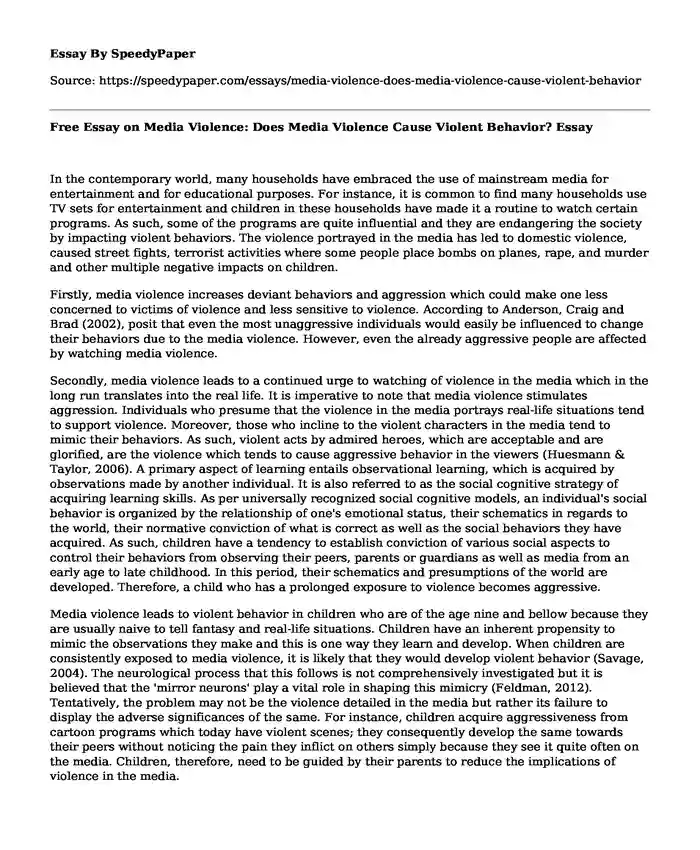In the contemporary world, many households have embraced the use of mainstream media for entertainment and for educational purposes. For instance, it is common to find many households use TV sets for entertainment and children in these households have made it a routine to watch certain programs. As such, some of the programs are quite influential and they are endangering the society by impacting violent behaviors. The violence portrayed in the media has led to domestic violence, caused street fights, terrorist activities where some people place bombs on planes, rape, and murder and other multiple negative impacts on children.
Firstly, media violence increases deviant behaviors and aggression which could make one less concerned to victims of violence and less sensitive to violence. According to Anderson, Craig and Brad (2002), posit that even the most unaggressive individuals would easily be influenced to change their behaviors due to the media violence. However, even the already aggressive people are affected by watching media violence.
Secondly, media violence leads to a continued urge to watching of violence in the media which in the long run translates into the real life. It is imperative to note that media violence stimulates aggression. Individuals who presume that the violence in the media portrays real-life situations tend to support violence. Moreover, those who incline to the violent characters in the media tend to mimic their behaviors. As such, violent acts by admired heroes, which are acceptable and are glorified, are the violence which tends to cause aggressive behavior in the viewers (Huesmann & Taylor, 2006). A primary aspect of learning entails observational learning, which is acquired by observations made by another individual. It is also referred to as the social cognitive strategy of acquiring learning skills. As per universally recognized social cognitive models, an individual's social behavior is organized by the relationship of one's emotional status, their schematics in regards to the world, their normative conviction of what is correct as well as the social behaviors they have acquired. As such, children have a tendency to establish conviction of various social aspects to control their behaviors from observing their peers, parents or guardians as well as media from an early age to late childhood. In this period, their schematics and presumptions of the world are developed. Therefore, a child who has a prolonged exposure to violence becomes aggressive.
Media violence leads to violent behavior in children who are of the age nine and bellow because they are usually naive to tell fantasy and real-life situations. Children have an inherent propensity to mimic the observations they make and this is one way they learn and develop. When children are consistently exposed to media violence, it is likely that they would develop violent behavior (Savage, 2004). The neurological process that this follows is not comprehensively investigated but it is believed that the 'mirror neurons' play a vital role in shaping this mimicry (Feldman, 2012). Tentatively, the problem may not be the violence detailed in the media but rather its failure to display the adverse significances of the same. For instance, children acquire aggressiveness from cartoon programs which today have violent scenes; they consequently develop the same towards their peers without noticing the pain they inflict on others simply because they see it quite often on the media. Children, therefore, need to be guided by their parents to reduce the implications of violence in the media.
Summarily, today the media has continuously presented quite influential programs which have contributed to brutality and aggression in individuals who tend to mimic these acts. Media violence has contributed to behavioral changes in individual who eventual are perpetrators of rape, street fights, murder and many vices. Media violence contributes to violent behaviors and it is learned by different ages non-aggressive and those who are already aggressive.
References
Craig A. Anderson, a., & Brad J. (2002). The effects of media violence on society. Science, (5564), 2377.
Feldman, R. (2012). Psychology and your life (2nd Ed.). New York, NY: McGraw-Hill Education.
Huesmann, L., & Taylor, L. (2006). The role of media violence in violent behavior. Annual Review of Public Health, 27(1), 393-415. doi: 10.1146/annurev.publhealth.26.021304.144640
Savage, J. (2004). Does viewing violent media really cause criminal violence? A methodological review. Aggression and Violent Behavior, 10(1), 99-128. doi:10.1016/j.avb.2003.10.001
Cite this page
Free Essay on Media Violence: Does Media Violence Cause Violent Behavior?. (2022, Jun 03). Retrieved from https://speedypaper.net/essays/media-violence-does-media-violence-cause-violent-behavior
Request Removal
If you are the original author of this essay and no longer wish to have it published on the SpeedyPaper website, please click below to request its removal:
- Financial Management Questions. Paper Example.
- Operations Management Essay Example
- Free Essay on Electronic Health Records Software
- Free Essay on the Training for Sales Representatives
- Project Management Triple Constraint
- Most Memorable Day of My Life. Essay Sample
- Free Essay. The Cherokee Tribe of Native Americans
Popular categories





